Episodes

Tuesday Aug 29, 2023
Tuesday Aug 29, 2023
The Guardian Angel: Eucharistic Miracles, Perpetual Adoration, True Peace in the World

Monday Aug 28, 2023
Monday Aug 28, 2023
Stand in the Gap with us and Saint Augustine of Hippo 8/28/2023
His writings influenced the development of Western philosophy and Western Christianity, and he is viewed as one of the most important Church Fathers of the Latin Church in the Patristic Period. His many important works include The City of God, On Christian Doctrine, and Confessions.
Augustine shines out as one whose theology focuses on the central mystery of the Christian faith, God's gracious drawing of humanity into the divine life through the work of the incarnate Word and the life-giving Spirit.
Augustine has also taught us that the human race is united in sin and rebellion against God and cannot save itself. Those who have met with Christ have learned that they must trust him completely and not rely on their own efforts, qualities, or inheritance for their salvation.
For Augustine, love that is in accord with the truth of God's love must be an ordered love, in terms of everything being loved hierarchically according to its proper relationship to God. In fact, for Augustine, all virtue is ordered love.
The idea of truth Augustine believes comes not from ex- perience nor from reason but is innate in man. It cannot come from sense knowledge or reason for these are changeable and truth is not.
The rule, developed by Augustine of Hippo (354–430), governs chastity, poverty, obedience, detachment from the world, the apportionment of labour, the inferiors, fraternal charity, prayer in common, fasting and abstinence proportionate to the strength of the individual, care of the sick,
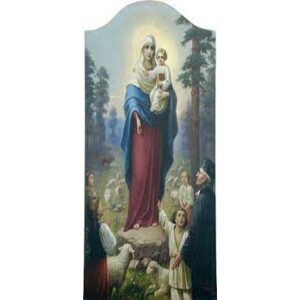
Monday Aug 28, 2023
Monday Aug 28, 2023
Join John Carpenter, Donald Hartley, and the Deeper Truth research team as they investigate Mary's visit to Lithuania in 1608.
First Widely Known Apparition of the Mother of God in Europe
Lithuania becomes the youngest daughter of the Church
In 1251, Lithuania was the last European nation to accept Christianity, becoming the youngest daughter of the Church.
There was a time when Lithuania came very close to leaving the Catholic faith. Something happened in 1608 in the little village of Siluva which turned back, once and for all, the tide of the Reformation heresy which was sweeping over Europe and threatening to engulf this little country.
Two hundred fifty years before Lourdes and Fatima the Blessed Virgin Mary appeared in the village of Siluva, Lithuania.
The story begins in 1457
The story of Our Lady of Siluva actually began in 1457, when Peter Giedgaudas, a diplomat for Vytautas the Great, built the first church in the area and gave the land to the Catholic Church. On one of his many travels he went to Rome and there obtained a magnificent painting of the Blessed Virgin Mary holding the child Jesus. He brought the painting back to Lithuania and put it in the sanctuary of the new church in Siluva.
For several generations the faithful worshiped God and honored the Blessed Mother in their little shrine church.

Sunday Aug 27, 2023
Sunday Aug 27, 2023
Stand in the Gap with us and Saint Monica 8/27/2023
St. Monica is one of those Saints who helps provide hope for parents who have seen their children grow up and have left the Church.
There is never a fool proof book that parents can find to offer help, but the Bible gives the direction. Unfortunately, biblical literacy and society has been rebelling against the bible.
When talking with friends who have experienced apostasy among their children, the favorite one liner I have shared is, “Remember St. Monica”, she prayed 30 years for her son who did in the end came home.
Prayer must be the first baseline support for anyone who has fallen from the faith. Though raised with Christian roots, St. Monica's parents gave her to a Pagan (Patricius) who wanted her hand in marriage. Patricius was known to have had a violent temper and his mother was a nuisance much of the time as she meddled living with them.
Remember, St. Monica prayed for both her Husband, (Patricius) and St Augustine for 30 years. St Paul wrote to the Corinthians, "that if a brother has a wife who is an unbeliever, and she consents to live with him, he should not divorce her. If any woman has a husband who is an unbeliever, and he consents to live with her, she should not divorce him. For the unbelieving husband is consecrated through his wife..." (1 Corinthians 7:12-14) Patricius died 371 A.D. just one year after he was Baptized into the Catholic Faith.
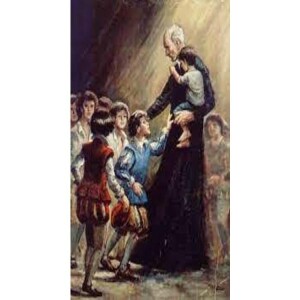
Saturday Aug 26, 2023
Saturday Aug 26, 2023
Stand in the Gap with us and Saint Joseph Calasanz 8/26/2023
Highlighting his pedagogical approach, Joseph Calasanz once wrote: “If from the very earliest years, a child is instructed in both religion and letters, it can be reasonably hoped that his life will be happy.” Accordingly, the motto of the Piarists is “Piety and Letters.”
He was a close friend of the renowned astronomer Galileo Galilei.
From Aragon where he was born in 1556, to Rome where he died 92 years later, fortune alternately smiled and frowned on the work of Joseph Calasanz. A priest with university training in canon law and theology, respected for his wisdom and administrative expertise, he put aside his career because he was deeply concerned with the need for education of poor children.
When he was unable to get other institutes to undertake this apostolate at Rome, Joseph and several companions personally provided a free school for deprived children. So overwhelming was the response that there was a constant need for larger facilities to house their effort. Soon, Pope Clement VIII gave support to the school, and this aid continued under Pope Paul V.
Other schools were opened; other men were attracted to the work, and in 1621 the community—for so the teachers lived—was recognized as a religious community, the Clerks Regular of Religious Schools—Piarists or Scolopi. Not long after, Joseph was appointed superior for life.
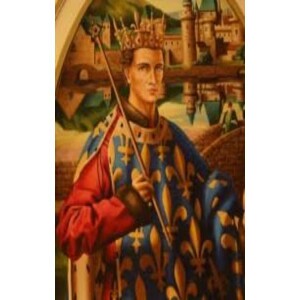
Friday Aug 25, 2023
Friday Aug 25, 2023
Saint Louis of France 8/25/2023
King Louis IX of France led a Crusade in the mid-1200s. He died during another Crusade in 1270. In 1297, to honor the king's efforts as a Crusader, the Roman Catholic Church made Louis IX a saint.
At his coronation, St. Louis bound himself by oath to act as God's anointed king. St. Louis is known for interpreting his kingly duties in the light of faith.
Louis IX, also called Saint Louis, (born April 25, 1214, Poissy, France—died August 25, 1270, near Tunis [now in Tunisia]; canonized August 11, 1297, feast day August 25), king of France from 1226 to 1270, the most popular of the Capetian monarchs.
St. Louis is known for the Gateway Arch, the tallest monument constructed in the United States at 630 feet (190 m). The Arch pays homage to Thomas Jefferson and St. Louis's position as the gateway to the West.
King Louis IX was the only French king to become a saint, but not the only French royal. In fact, his younger sister, Isabelle, is also recognized as a saint by the Franciscan Order. King Louis became Saint Louis when he was canonized in 1297, 27 years after his death.
At his coronation as king of France, Louis IX bound himself by oath to behave as God’s anointed, as the father of his people and feudal lord of the King of Peace. Other kings had done the same, of course. Louis was different in that he actually interpreted his kingly duties in the light of faith. After the violence of two previous reigns, he brought peace and justice.
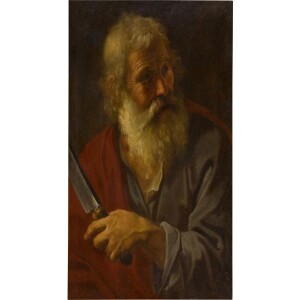
Thursday Aug 24, 2023
Thursday Aug 24, 2023
The Apostle St. Bartholomew, follower of Christ 8/242023
St. Bartholomew was one of the original 12 Apostles of Our Lord and Savior Jesus Christ. His name literally means "son of Tolomai", born in the "House of Tolomai" from Cana of Galilee.
Bartholomew most certainly knew the Bride Groom and guests at the famed wedding feast of Cana when Jesus performed His first public Miracle (John 2:1-11).
At the time of Jesus, Cana and Galilee in general had a strong economy based on the fishing industry. No doubt St. Bartholomew lived within the means of his household, but because of his friendship with St. Phillip, he had an encounter with Jesus that would change his life forever. St. John knew St. Bartholomew and lists him in his Gospel as "Nathanael" in respect to his strong faith and reliance on God.
At that time, there were many reports of messiahs and there were problems with the leaders of Israel, they were under Roman Rule and despair was a temptation. At one point, St. Bartholomew told his friend, St. Philip, "Can anything good come out of Nazareth?" Philip said to him, "Come and see." What St. Bartholomew did not know was that St. Philip had already met Jesus a couple of days before.
John 1:47 States, "Jesus saw Nathana-el coming to him, and said of him, "Behold, an Israelite indeed, in whom is no guile!" Think about that for a second, wouldn't that be great for Jesus to think of you that way? St. Bartholomew must of been strong in faith and conviction. From that time on St. Bartholomew would be counted with the 12 Apostles (Matthew 10:1-4, Mark 3:13-19, Luke 6:12-16).
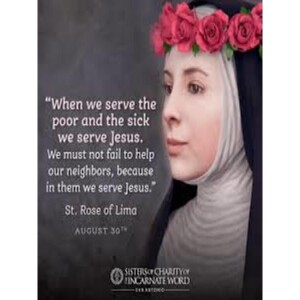
Wednesday Aug 23, 2023
Wednesday Aug 23, 2023
Saint Rose of Lima 8/23/2023
She is the patron saint of embroiderers, gardeners, florists, people who are harassed for their piety, and those suffering family problems. She is the patroness of the Americas, the indigenous people of the Americas, and of Peru, India, and the Philippines.
The Catholic Church says that many miracles followed her death: there were stories that she had cured a leper, and that, at the time of her death, the city of Lima smelled like roses; roses also started falling from the sky. Many places in the New World are named Santa Rosa after her.
The first canonized saint of the New World has one characteristic of all saints—the suffering of opposition—and another characteristic which is more for admiration than for imitation—excessive practice of mortification.
She was born to parents of Spanish descent in Lima, Peru, at a time when South America was in its first century of evangelization. She seems to have taken Catherine of Siena as a model, in spite of the objections and ridicule of parents and friends.
The saints have so great a love of God that what seems bizarre to us, and is indeed sometimes imprudent, is simply a logical carrying out of a conviction that anything that might endanger a loving relationship with God must be rooted out. So, because her beauty was so often admired, Rose used to rub her face with pepper to produce disfiguring blotches. Later, she wore a thick circlet of silver on her head, studded on the inside, like a crown of thorns.
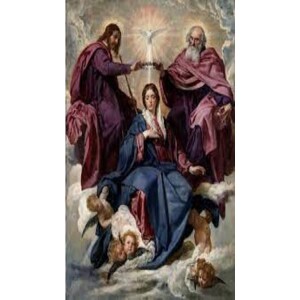
Tuesday Aug 22, 2023
Tuesday Aug 22, 2023
Queenship of the Blessed Virgin Mary 8/22/2023
The Memorial of the Queenship of Mary was first instituted in 1954 by Pope Pius XII. According to Catholic tradition, as Christ is king of the world and saves the people from their sins, Mary is queen over the earth because of her role in the story of divine redemption, serving as mother to the Savior.
Mary became Queen at the time she was assumed into Heaven. It was then that she received the full reward prepared for her, being made perfect by the glorification not only of her soul, but also of her body.
On August 22, the Roman Catholic Church celebrates a memorial in honor of the Queenship of Mary. This memorial is placed an octave, that is, eight days after celebrating Mary's Assumption into Heaven. The Queenship can be considered a prolongation of the celebration of the Assumption.
The Catholic faith states, as a dogma, that Mary was assumed into heaven and is with Jesus Christ, her divine son. Mary should be called Queen, not only because of her Divine Motherhood of Jesus Christ, but also because God has willed her to have an exceptional role in the work of eternal salvation.
Finally, Mary's queenship can be seen in the great vision described in Revelation 12: “And a great portent appeared in heaven, a woman clothed with the sun, with the moon under her feet, and on her head a crown of twelve stars; she was with child and she cried out in her pangs of birth, in anguish for delivery”
'just as . . . God, by making all through His power, is Father and Lord of all, so the blessed Mary, by repairing all through her merits, is Mother and Queen of all; for God is the Lord of all things, because by His command He establishes each of them in its own nature, and Mary is the Queen

Tuesday Aug 22, 2023
Tuesday Aug 22, 2023
And as they were eating,
He took bread, and blessed, and broke it,
and gave it to them, and said,
'Take; this is my body.'
Mark 14:22)
And he took a cup, and when he had given thanks
he gave it to them, and they all drank of it.
And he said to them,
'This is my blood of the covenant,
which is poured out for many.'
(Mark 14:23-24)
The simplest way to express what Christ asks us to believe about the Real Presence is that the Eucharist is really He. The Real Presence is the real Jesus. We are to believe that the Eucharist began in the womb of the Virgin Mary; that the flesh which the Son of God received from His Mother at the Incarnation is the same flesh into which He changed bread at the Last Supper; that the blood He received from His Mother is the same blood into which He changed wine at the Last Supper. Had she not given Him His flesh and blood there could not be a Eucharist.
We are to believe that the Eucharist is Jesus Christ - simply, without qualification. It is God become man in the fullness of His divine nature, in the fullness of His human nature, in the fullness of His body and soul, in the fullness of everything that makes Jesus Jesus. He is in the Eucharist with His human mind and will united with the Divinity, with His hands and feet, His face and features, with His eyes and lips and ears and nostrils, with His affections and emotions and, with emphasis, with His living, pulsating, physical Sacred Heart. That is what our Catholic Faith demands of us that we believe. If we believe this, we are Catholic. If we do not, we are not, no matter what people may think we are.
Father John A. Hardon
